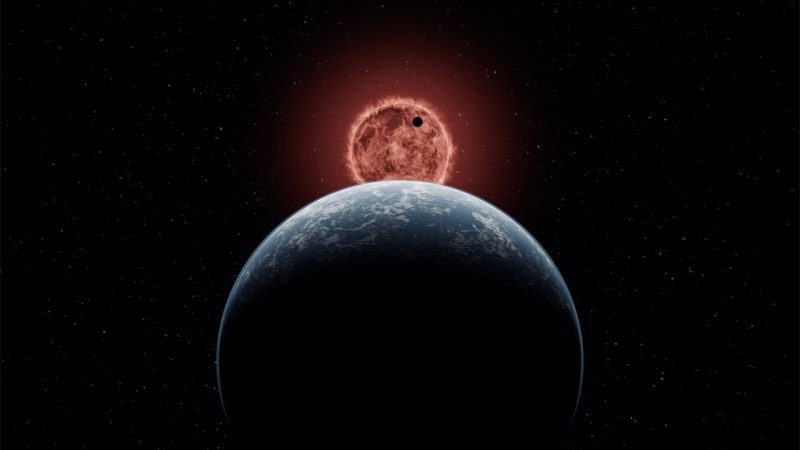
Among exoplanets in our galaxy, super-Earths and mini-Neptunes are two of the most common types. Even though neither exists in our own solar system, astronomers have discovered many in other solar systems. Now, researchers at the University of Liège in Belgium say they have found a pair of these worlds in another solar system 150 light-years away. What makes this system extra interesting, however, is that these two planets are in a synchronous dance around their red dwarf star. The astronomers made the discovery using NASA’s Transiting Exoplanet Survey Satellite (TESS) and ground-based telescopes.
The researchers first published their peer-reviewed findings in Astronomy and Astrophysics on April 12, 2023. The University of Liège announced the discovery on May 25, 2023.
A collaborative discovery
Researchers in Europe and the U.S. collaborated to make the discovery, using data from both TESS and ground-based telescopes. Astrophysicist Francisco J. Pozuelos, the lead author, explained:
TESS is conducting an all-sky survey using the transit method, that is, monitoring the stellar brightness of thousands of stars in the search for a slight dimming, which could be caused by a planet passing between the star and the observer. However, despite its power to detect new worlds, the TESS mission needs support from ground-based telescopes to confirm the planetary nature of the detected signals.
TESS is designed specifically to search for exoplanets, planets orbiting other stars. This includes planets like super-Earths and mini-Neptunes, as well as Earth-sized rocky worlds.
A super-Earth and mini-Neptune
The two planets – TOI-2096 b and TOI-2096 c – are both larger than Earth. TOI-2096 b isn’t much bigger though, with a radius only 1.2 times that of Earth. This makes it a super-Earth, a rocky world larger than our own planet, but smaller than Neptune.
TOI-2096 c, on the other hand, is 1.9 times Earth’s radius. The researchers say that this likely makes it a mini-Neptune. It may have a small rocky and icy core, but it would be enveloped in a deep, thick atmosphere rich in either hydrogen or water. That means it would be similar to the ice giants in our solar system, Uranus and Neptune, but smaller. But these exoplanets also offer a unique look at both super-Earths and mini-Neptunes and how they may have formed. Co-author Mathilde Timmermans said:
These planets are of crucial importance given their sizes. The formation of super-Earths and mini-Neptunes remains a mystery today. Several formation models try to explain it, but none fits the observations perfectly. TOI-2096 is the only system found to date with a super-Earth and a mini-Neptune precisely at the sizes where the models contradict each other. In other words, TOI-2096 may be the system we’ve been looking for to understand how these planetary systems have formed.
Two worlds in a synchronized dance
A super-Earth and mini-Neptune in the same system is interesting on its own. But there’s more. The orbits of the two planets are synchronized with each other.
In the same time that the outer planet completes one orbit, the inner planet completes two. You could say that the planets are in a kind of cosmic dance with each other. Timmermans explained:
Making an exhaustive analysis of the data, we found that the two planets were in resonant orbits: for each orbit of the outer planet, the inner planet orbits the star twice.
Their periods are, therefore, very close to being a multiple of each other, with about 3.12 days for planet b and about 6.38 days for planet c. This is a very particular configuration, and it causes a strong gravitational interaction between the planets. This interaction delays or accelerates the passage of the planets in front of their star and could lead to the measurement of the planetary masses using larger telescopes in the near future.

Super-Earth and mini-Neptune observations with Webb
Luckily, these two planets are well-suited for observations with NASA’s Webb Space Telescope. Pozuelos said:
Furthermore, these planets are among the best in their category to study their possible atmospheres. Thanks to the relative sizes of the planets with respect to the host star, as well as the brightness of the star, we find that this system is one of the best candidates for a detailed study of their atmosphere with the JWST space telescope. We hope to be able to do this quickly by coordinating with other universities and research centers. These studies will help confirm the presence of an atmosphere, extensive or not, around planets b and c, thus giving us clues as to their formation mechanism.
Bottom line: Astronomers say they’ve discovered a super-Earth and mini-Neptune exoplanet system where the orbits of the two worlds are synchronized in a cosmic dance.











